UNIT 8
Metabolism
The endothermic process, are reactions that take place when the system absorbs energy from its surroundings in the form of heat. Few examples for the endothermic process are ammonium chloride, dry ice, alkanes cracking, photosynthesis, evaporating liquids, melting ice, thermal decomposition, ammonium chloride in water and much more.
The exothermic reaction is the reverse reaction that occurs in an endothermic reaction. In this process the system releases energy by light or heat to its surrounding. Few examples of this reaction deposition of dry ice, neutralization, burning a substance, respiration, reactions of fuels, deposition of dry ice, solution of sulfuric acid into water
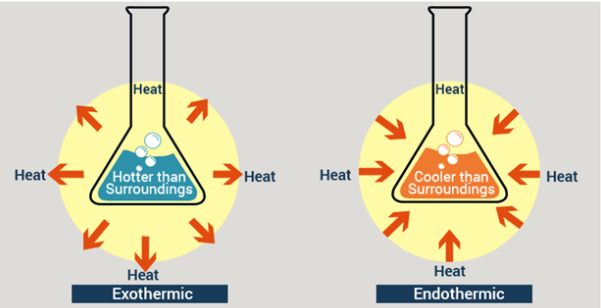
Fig 1: The differences that occur in both reactions, in an Endothermic reaction heat is absorbed into the system, where as in exothermic reactions heat is given out from the system.
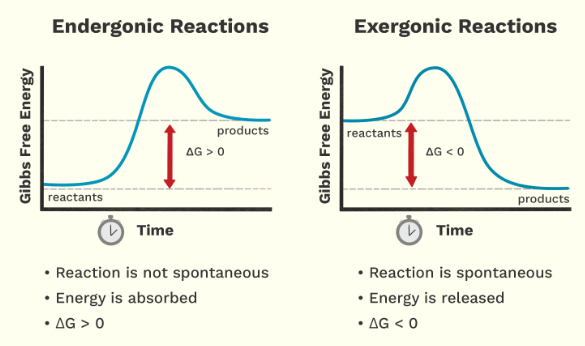
Fig 2: The difference between endergonic and exergonic reactions.
ΔG = ΔGo + RT InQ
Q is the reaction quotient
There is no free energy change when equilibrium is reached i.e. ΔG = 0 and Q becomes equal to equilibrium constant. Hence the above equation becomes.
ΔGo = –RT In K(eq)
or ΔGo = –2.303 RT log K(eq)
2. In the case of galvanic cells. The electrical work done by the cell is related to Gibbs energy change ΔG.
ΔG = -nFE(cell) where n = no. of moles of electrons involved
F = the Faraday constant
E = emf of the cell
If reactants and products are in their standard states ΔGo = –nFEocell
The Individual Reactions of Glycolysis
2. The pathway of glycolysis can be seen as consisting of 2 separate phases. The first phase requires energy in the form of ATP for the chemical priming phase, and the second is considered to be the energy-yielding phase. In the first phase, 2 equivalents of ATP are used to convert glucose to fructose 1,6-bisphosphate (F1,6BP). In the second phase F1,6BP is degraded to pyruvate, with the production of 4 equivalents of ATP and 2 equivalents of NADH.
GLYCOLOSYS YIELDS: 8 ATP; 2NADH + H+, 4 ATP, -2 ATP
C6H12O6 +2NAD+ ->2C3H4O3+2NADH+2H+

Fig: 3 The steps involved in glycolysis
3. In the glycolysis cycle pyruvate molecules are produced and they contain a lot of energy in the bonds present between their molecules. The pyruvate molecules are processed through the krebs cycle to convert the energy into ATP so that it is used in all cell activities. Krebs cycle, is also called as the Citric acid cycle. The krebs cycle occurs in the Mitochondria of the cell.
4. Before entering the Krebs cycle, pyruvate has to be converted into acetyl CoA. This is achieved by the removal of a CO2 molecule from pyruvate and then removing an electro to reduce an NAD+ into NADH. An enzyme called coenzyme A combines with the remaining acetyl to make acetyl CoA, after which it enters the Krebs cycle.
The steps in the krebs cycle are summarized below:
In the Krebs cycle, during the glycolysis process to pyruvate molecules from one glucose, each glucose is processed through the Krebs cycle two times. For each molecule of glucose ,6 NADH2+,2FADH2 and 2 ATP are formed.
Krebs cycle yields (2 cycles,1 for each pyruvate):24 ATP 6 NADH +h ,2 GTP,2FADH.
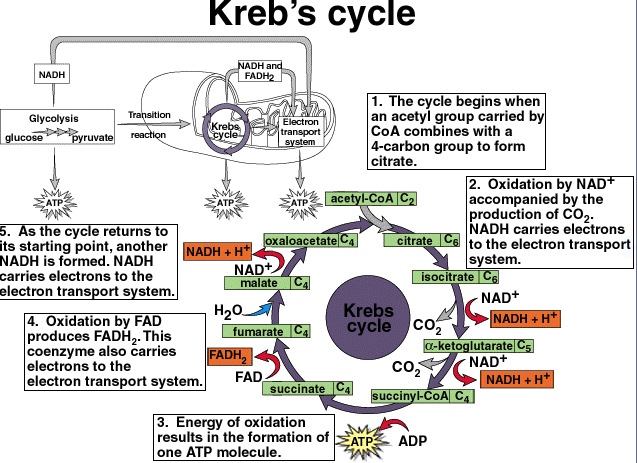
Fig 4: Overview of Krebs Cycle
3. Carbohydrates are involved in many essential metabolic pathways. Plants utilize sunlight and synthesize carbohydrates from carbon dioxide and water through photosynthesis, energy is stored in the form of carbohydrates through this sunlight internally. In cellular respiration the stored carbohydrate is broken down to release energy by animals and fungi that consume plants.
4. Both animals and plants store the released energy temporarily in the form of high-energy molecules, called ATP, for use in various cellular processes.
5. Photosynthesis is a chemical reaction in which carbon dioxide and water combine to produce glucose and oxygen. Sunlight forms the source of energy, which is absorbed by pigments, called chlorophyll. Chlorophyll is green in colour and is the pigment that gives plants their green colour
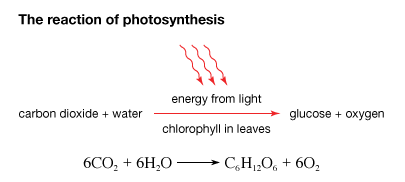
Glycolysis
Glycolysis
1. Glycolysis takes place in the cytoplasm
2. It can Occur in the presence or absence of oxygen
3. They Involve ten enzyme-catalysed reactions
4. Broken down into 2 molecules of pyruvate
5. Steps
A. Glucose is converted to a 6-C diphosphate. This uses 2 ATP's
B. The 6-C molecule is broken down into 2, 3-C molecules
C. The 2, 3-C sugars are converted to Pyruvate, gaining 4 ATP and 2 NADH
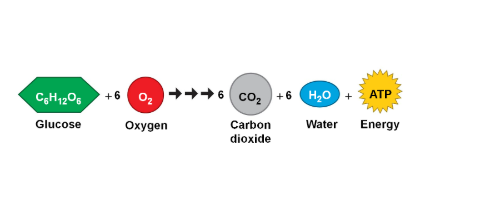
Fig 5: Glycolysis is the process during which glucose molecules are broken down into two pyruvate molecules, while storing energy released during this process as ATP and NADH with water and carbon dioxide.

Anabolic pathways require an energy input to synthesize complex molecules from simpler ones. A good example of anabolic pathway is the synthesis of sugar from CO2. Other examples include breaking down of amino acid to form large proteins and the synthesis of new DNA strands from nucleic acid building blocks. These processes are very critical to the life of each cell, and take place constantly, and eventually these processes demand energy provided by ATP molecules and other high-energy molecules like NADH (nicotinamide adenine dinucleotide) and NADPH.
Catabolic pathways involve the breaking down of complex molecules into simpler ones, releasing the chemical energy is stored in the bonds of those molecules. Some catabolic pathways can capture the chemical energy to produce ATP, which is the energy molecule used to power all cellular processes. Other energy-storing molecules, such as lipids, are also broken down through similar catabolic reactions to release energy and make ATP.
References: